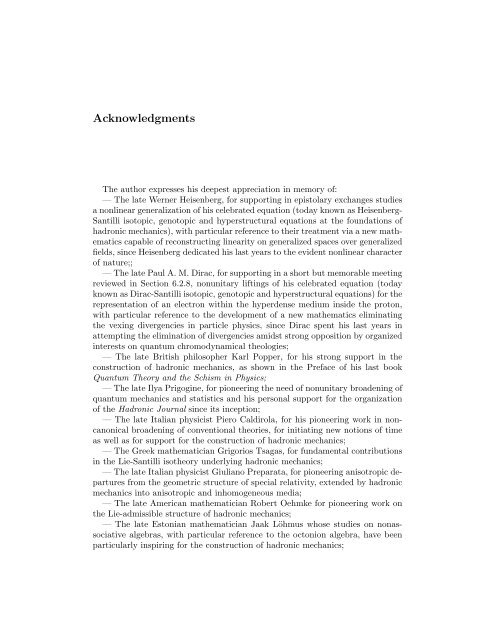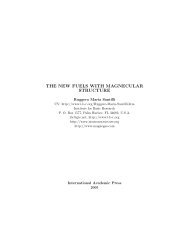hadronic mathematics, mechanics and chemistry - Institute for Basic ...
hadronic mathematics, mechanics and chemistry - Institute for Basic ...
hadronic mathematics, mechanics and chemistry - Institute for Basic ...
Create successful ePaper yourself
Turn your PDF publications into a flip-book with our unique Google optimized e-Paper software.
Acknowledgments<br />
The author expresses his deepest appreciation in memory of:<br />
— The late Werner Heisenberg, <strong>for</strong> supporting in epistolary exchanges studies<br />
a nonlinear generalization of his celebrated equation (today known as Heisenberg-<br />
Santilli isotopic, genotopic <strong>and</strong> hyperstructural equations at the foundations of<br />
<strong>hadronic</strong> <strong>mechanics</strong>), with particular reference to their treatment via a new <strong>mathematics</strong><br />
capable of reconstructing linearity on generalized spaces over generalized<br />
fields, since Heisenberg dedicated his last years to the evident nonlinear character<br />
of nature;;<br />
— The late Paul A. M. Dirac, <strong>for</strong> supporting in a short but memorable meeting<br />
reviewed in Section 6.2.8, nonunitary liftings of his celebrated equation (today<br />
known as Dirac-Santilli isotopic, genotopic <strong>and</strong> hyperstructural equations) <strong>for</strong> the<br />
representation of an electron within the hyperdense medium inside the proton,<br />
with particular reference to the development of a new <strong>mathematics</strong> eliminating<br />
the vexing divergencies in particle physics, since Dirac spent his last years in<br />
attempting the elimination of divergencies amidst strong opposition by organized<br />
interests on quantum chromodynamical theologies;<br />
— The late British philosopher Karl Popper, <strong>for</strong> his strong support in the<br />
construction of <strong>hadronic</strong> <strong>mechanics</strong>, as shown in the Preface of his last book<br />
Quantum Theory <strong>and</strong> the Schism in Physics;<br />
— The late Ilya Prigogine, <strong>for</strong> pioneering the need of nonunitary broadening of<br />
quantum <strong>mechanics</strong> <strong>and</strong> statistics <strong>and</strong> his personal support <strong>for</strong> the organization<br />
of the Hadronic Journal since its inception;<br />
— The late Italian physicist Piero Caldirola, <strong>for</strong> his pioneering work in noncanonical<br />
broadening of conventional theories, <strong>for</strong> initiating new notions of time<br />
as well as <strong>for</strong> support <strong>for</strong> the construction of <strong>hadronic</strong> <strong>mechanics</strong>;<br />
— The Greek mathematician Grigorios Tsagas, <strong>for</strong> fundamental contributions<br />
in the Lie-Santilli isotheory underlying <strong>hadronic</strong> <strong>mechanics</strong>;<br />
— The late Italian physicist Giuliano Preparata, <strong>for</strong> pioneering anisotropic departures<br />
from the geometric structure of special relativity, extended by <strong>hadronic</strong><br />
<strong>mechanics</strong> into anisotropic <strong>and</strong> inhomogeneous media;<br />
— The late American mathematician Robert Oehmke <strong>for</strong> pioneering work on<br />
the Lie-admissible structure of <strong>hadronic</strong> <strong>mechanics</strong>;<br />
— The late Estonian mathematician Jaak Löhmus whose studies on nonassociative<br />
algebras, with particular reference to the octonion algebra, have been<br />
particularly inspiring <strong>for</strong> the construction of <strong>hadronic</strong> <strong>mechanics</strong>;














